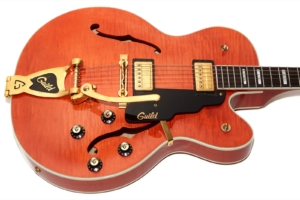
I scored this guitar in mint condition on eBay for the right price and have put it through my normal review process (and then some). Read on to see what I like and dislike about this very orange Guild guitar.
Introduction
This guitar is a Guild X170T which means that it’s a Guild X-170 with a Tremolo – hence the T. The rant about it being a vibrato and not a tremolo tailpiece has been redacted. If you’d like to learn more about regular Guild X170s, I did a writeup of one here. The orange finish is called Tennessee Orange and was an option as we’ll see later in the Finish section, though all of the Mars X170Ts I’ve ever seen came in this color. So what makes this an X170T Mars vs. a regular old run-of-the-mill X170T? That has to do with a now defunct chain of stores named Mars Music.
Mars Music was a chain of musical instrument stores founded in Florida in 1996 and expanded to 49 stores in 20 states by 2002 which is likely why it went bankrupt in that same year. In its heyday, Mars Music was very much like Guitar Center and Sam Ash are today.
Note: There are Mars Music stores out there today that are not the same chain of stores as the one being discussed here.
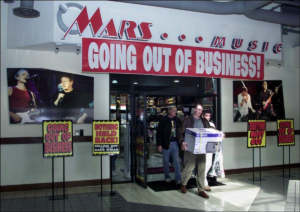
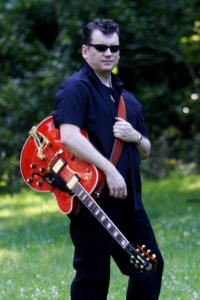
I bought the guitar on eBay and he only told me this information after the sale was done because he didn’t want to sell it as a prototype or hype it in any way. When I asked Hans about it he insisted that it wasn’t a prototype so there’s a fair bit of discrepancy about that particular guitar, though it did help to make this old dork look cool, and that’s no small feat.
Quote from Rick Powel from when I bought that first X170T (reprinted with permission):
At the time I was the head guitar buyer for MARS Music (54 stores nationally at the time) and the guitar was a project between myself and Bill Acton who was the project manager for Guild at Fender during that period. We didn’t have Gretsch as a line at the time and were looking for a 6120 killer. I think we succeeded. This guitar was the prototype, we did a limited edition of 150 later on that had some changes; the coil tap switch was moved to the lower bout, the woods were not as nice and I believe some of the guitars got shipped without trems.
When I asked Hans about my early model, he told me that indeed the early ones came with both switches on the bass side (like my first one) but insisted that the one I had was not the prototype, though it was one of the very early models. My completely unscientific guess is that Guild probably sent one from the first batch to Mars as a prototype (from the Mars point of view), but I’ve been wrong before.
Years later, while writing this article, I emailed Rick Powel again to ask his permission to use his quotes, which he granted, along with this information after I had asked some questions regarding the switch positions and the addition of the metal bridge (edited for brevity) since normal X170s have a rosewood bridge:
With Guild anything would be possible, they were not used to doing Custom runs. It’s also been 10 years from the design discussion phase and I suppose it’s possible that Guild made the first batch like the proto instead of implementing the switch placement change, I only remember seeing the version with the switch on the lower bout.
The metal bridge is critical for both the single coil bite to cut through, keep good definition in humbucker mode and stand up to the torture of a rockabilly [player] who likes trem. I probably had a couple of hundred special runs done between MARS and GC, I wish I had taken pics along the way, it would have made a great book.
In 2000 the 7 string guitar was king and you could not give a Guild away (solid or archtop); I am sure I was the only dealer ordering X170’s in quantity.
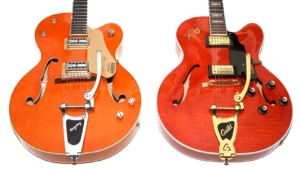

This pic was also used on the cover of a Guild Gallery magazine which Guild used as its catalog for the years around 1998-1999 and it was also used as the cover for her album Everything’s Gonna Be Alright (link) which was released in 1998, though that’s too early for it to be a Mars Guild.
This cover of the Guild Gallery and the included article are focused on Deana Carter with her Guild X170 in Tennessee Orange. That’s right – the guitar in these pics is not an X170T but rather a regular old X170 finished in the same cool color. How can I tell? Three ways:
- First, the guitar has only one switch which I take it to mean that it is not a Mars special-order Guild
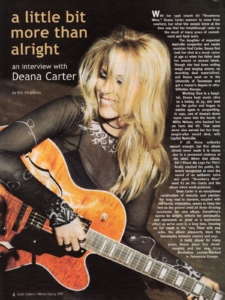
- Second, the guitar does not have a Bigsby tailpiece while also having the rosewood bridge of an X170
- Third, and perhaps most importantly, the article plainly calls the guitar a Guild X-170 Manhattan in custom-finished Tennessee Orange.
While these pictures don’t show the guitar in question, there was just no way I was going to skip including them because they’re just so cool. Also, and let’s be honest here, any page looks better with a picture or two of Deana Carter on it. When she’s playing an orange Guild, well then all the better.
Finish

What I’d like to point out is the color, because when I first got it I was convinced that someone had bought the guitar and hung it on his wall in the sunlight causing it to fade. The reason I thought this was because my first one was much darker and more intense looking. Expecting that same deep orange when i first opened the case, I was disappointed to see more of a creamesicle color.
My first one (shown to the right) was much darker and though my lighting skills have advanced in the time between when these two pictures were taken, the difference in the orange hue is not due to lighting – the older one was indeed that much darker. You can see this in the picture of the dork (me) holding it in the picture in the introduction. Don’t be distracted by the fact that I may be the whitest guy on earth trying to look cool with a guitar. I don’t wear sunglasses for the glamour, I wear them because the ambient light from a thunderstorm hurts my eyes. That’s how white I am.
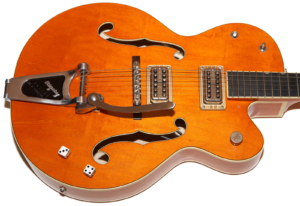
While the Guild X170 was available in a variety of finishes, so far as I know the Mars X170T only came in orange. My guess would be that if you’re going to try and make a Gretsch killer, you’re probably going to go for the most iconic color, and thanks to the likes of Brian Setzer who was at the height of his big-band resurgence at the time, that would be orange.
Fretboard and Neck
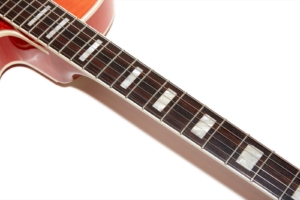
The fretboard is a nice dark rosewood and the fret markers are pearloid blocks that look classy as hell. The entire neck and body is bound, though the binding is simple and not the 7-layer stuff seen on models like the X-500 and X-700. This guitar, though pretty, wasn’t meant for playing smooth jazz with a pipe and smoking jacket. It was designed for rockabilly lunacy with style.
The fretboard radius is a fairly flat 14″ and the neck is an absolutely wonderful C-shape with enough depth to not be skinny without being huge. The neck is 1 11/16+ inches at the nut and just gets better and beefier where it counts. This neck is as close to my dream neck as it gets.
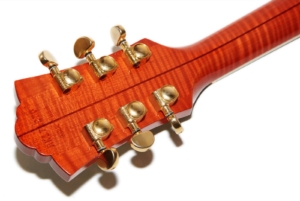
Did I mention the neck flame? Because look at that neck flame. That’s not an artifact from me boosting the contrast, either. This guitar’s neck has monster flame. I mean, the guitar itself is no slouch, but it doesn’t hold a candle to the neck. The neck is a finished a bit darker than the top of the guitar and more closely resembles how the entirety of my first X170T was finished. And yes, I’m clearly still bummed about selling that guitar.
Build Quality
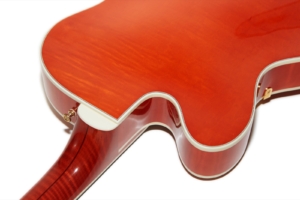
The neck joint is a work of art on this guitar and is solid enough to paddl…, er, play for a very long time. The finish is without blemish, and the guitar looks like it rolled off the line of a custom shop a week ago, and not from the Westerly Guild plant some 18 years ago as the serial number suggests.
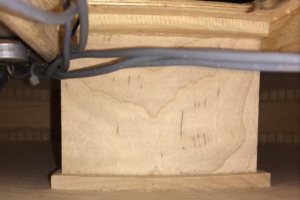
There is a sound block under the bridge that joins the top and bottom of the guitar for feedback suppression and stability. This block is only about 1/2 or 3/4 of an inch thick but I think it’s one of the big reasons why the guitar feels so solid.
This guitar weighs in at 7 pounds, 13 ounces (3.54 kilos) which is heavy enough to feel solid while being light enough to still be nimble. This is a big guitar, but it’s also mostly air. It is, however, exceedingly well balanced and plays like a dream.
Pickups
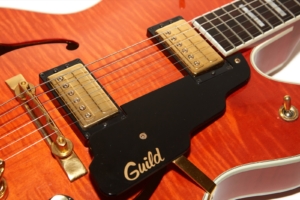
I’ve never liked Fender HB-1s and these were no exception. The fact that the neck pickup was mounted backwards didn’t help matters and to my ears the neck pickup in humbucker mode sounded muffled and bland. I don’t know if someone flipped the pickup around to make the adjustment screws line up or if it came that way from the factory but I didn’t care much because I ripped them out after recording them. The factory Fender HB-1 in the neck read 7.6k Ω and the bridge read 8.16k Ω.

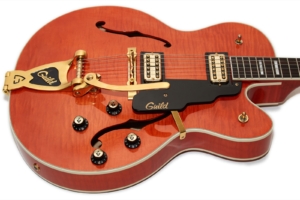
I was surprised to discover that a set of vintage Guild HB-1s did fit into the pickup routes, though the rings did not match up and would require alteration to the guitar to make them work. I thought about doing that because I love the look of the HB-1s, but the tone I was chasing was met by the Sezters. The TV Jones Setzer pickups make this guitar into the monster that it should have been from the factory.
Electronics
The electronics are fairly straightforward and are similar to any other two-humbucker 4-knob guitar out there, though the Mars X170T does include a coil-split switch which is not all that unusual in and of itself. Of course the way the coil split is accomplished seems a little unusual for no other reason than the very strange looking toggle used to accomplish the split.
A quick side rant of a pedantic nature is in order. If you don’t care about the difference between a tap and a split, scroll down to where it says, “OK, I’m done.”
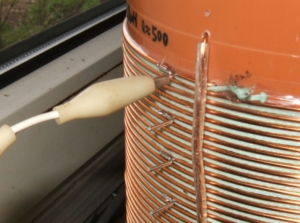
A coil split is used with humbucker pickups to isolate one of the coils from the other. This is done by shunting (basically making a short circuit) of the link between the two coils to ground which removes the secondary coil from the circuit. Though it’s possible to have coil taps in a guitar pickup, they would generally only be found in single-coil models. It is relatively rare to find coil taps in guitars and pretty common to find coil splits. Here’s another hint: If the guitar has humbuckers, it’s probably a split. If they’re single coils, then they’re taps (you can’t split the coils if there’s only one.)
OK, I’m done.
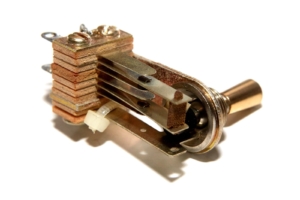
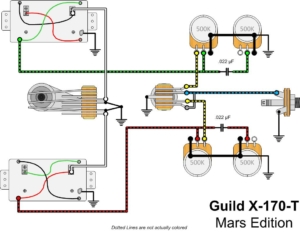
The controls are all WD-500 500 Ω pots and the pickup selector switch is a typical long 3-way toggle like the ones found in Les Pauls. The capacitors are ceramic disks and each are rated at .022 μF.
Hardware
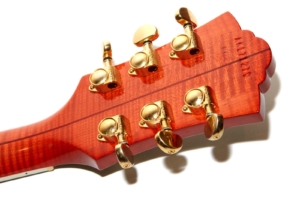
The knobs on the guitar are gold G-Shields knobs that are practically impossible to replace since Guild currently (2017) does not make a guitar with the same knobs, though they do make them in silver.
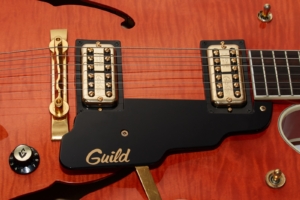
The bridge on this guitar is built for a wound 3rd string which I think is dumb for a rockabilly themed guitar. For straight-up jazz, sure, I’d go for the wound 3rd, but for the rockin’ Guildsby-abusing slap-back riddled noise I’ll be making I need a plain 3rd for my bending pleasure. If you’re wondering how to tell the difference, in the picture above you can see that the third string is compensated to be the shortest of the wound strings. With a plain 3rd, the 3rd string would be compensated as the longest of the plain strings (see the playability section for an example).
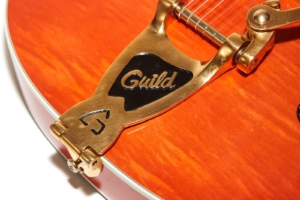
The Guildsby on this guitar as well as every Guild I’ve owned so equipped has been smooth and wonderful to play. If I were to complain about anything it would be stringing the damn things. I would quite literally rather string a Floyd Rose floating bridge than restring any Bigsby. Brian Setzer actually made stringing and tuning stability better on his guitars by adding locking tuners. I may consider that if I ever end up playing out again as the benefits are real.
Sound
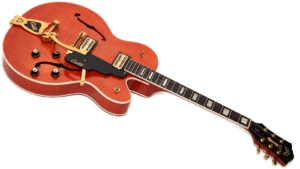
Fender HB1s
ODS-100
Open Chords
A7 Barre Chord
D-Shape Chords
Stray Cat Strut End
’65 Bassman
Sleepwalk
For the recordings I once again used my Macbook Pro connected to my Axe-FX II XL+ via USB. This may be the last time I do this unless I can figure out the dropout issues (edit: I’ve since figured it out but I can’t re-record with the removed pickups).
The recordings are humbucker; neck, middle, bridge, then coil-split; neck, middle, bridge. The last one is just the intro to Sleepwalk (neck pickup in single coil mode) on my custom-dialed-in ’65 Bassman patch with tape delay dialed in by me. All guitar knobs are on 10 at all times.
Again, for me the guitar is all but useless with the pickups in humbucker mode, but for a jazz player comping chords that may not be the case. I would tend to chose a traditional X-170 for those duties, but if you’re a normal person who doesn’t have too many guitars, then this guitar could certainly play both roles.
TV-Jones Setzers
ODS-100
Open Chords
A7 Barre Chord
D-Shape Chords
Stray Cat Strut End
’65 Bassman
Sleepwalk – neck
Sleepwalk – bridge
For my uses, the TV Jones pickups put this guitar right smack where I need it to be and I could not be happier with the results. I endeavored to play they same samples with the replacement pickups and with the Sleepwalk example I played it both with the neck pickup and the bridge pickup because while i usually play it with the neck, Brian Setzer plays it with the bridge so I figured I’d sample both.
To my ears the recordings don’t seem to show the difference between the pickups very well, but with the guitar and amp in the room with me the difference is immense. The TV Jones add that high end jangle and shimmer that I was after and they make the guitar sound much closer to the Brian Setzer Stray Cat fronting a big brass band tone I’ve been chasing for years.
Where the neck pickup was dull and lifeless before, with the TV Jones pickups the neck pickup becomes wonderfully toneful and harmonic in a way that the Fender HB1s simply cannot reproduce. I’ve said it before and I’ll say it here again, Fender killed Guild electrics by adding these terrible pickups to the guitars,
Playability
I love playing this guitar. Seated, standing, it doesn’t matter; it just feels right. The neck is great, the action is great, it looks great, it sounds great in single coil mode (even better with the TV Jones pickups), and it’s just a blast to play. Every time I play an X170T Mars out in public it gets comments. I’ve had people say, “Nice Gretsch!” because they’ve come to associate orange guitars like this with Brian Setzer, and to be fair I’ve been playing Brian Setzer tunes when that happens, so I can’t really blame them.

About the only quirk for me is the fact that I always either add a penny or get a longer spring for the Guildsby, but to be fair I do that on every Bigsby-equipped guitar I own including all the Gretsches and all the Starfire IIIs I’ve had.
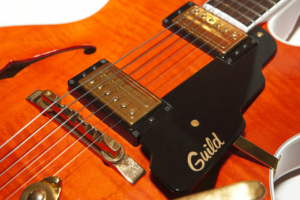
Conclusion
As an unapologetic raving Guild lunatic fanboy, I tend to love them all, but this one is one of my absolute favorites. I was a complete idiot for selling the first one I owned, and I was lucky enough to find this one in mint condition so I’ll probably hang on to it for quite some time.
My only real beefs with the guitar are the pickups and now that TV Jones has its universal mount system and rings that fit, that problem is no longer an issue for me. If you look at these two pics carefully you’ll see that they’re before and after pics with the second one showing the TV Jones pickups, which I think look absolutely killer.
If you’re not an absolute tone snob you’ll probably be fine with the Fender HB1s, as there are plenty of people out there who like them, especially in single coil mode. The TV Jones Setzer pickups just sound better to my ears and better is, well, better!
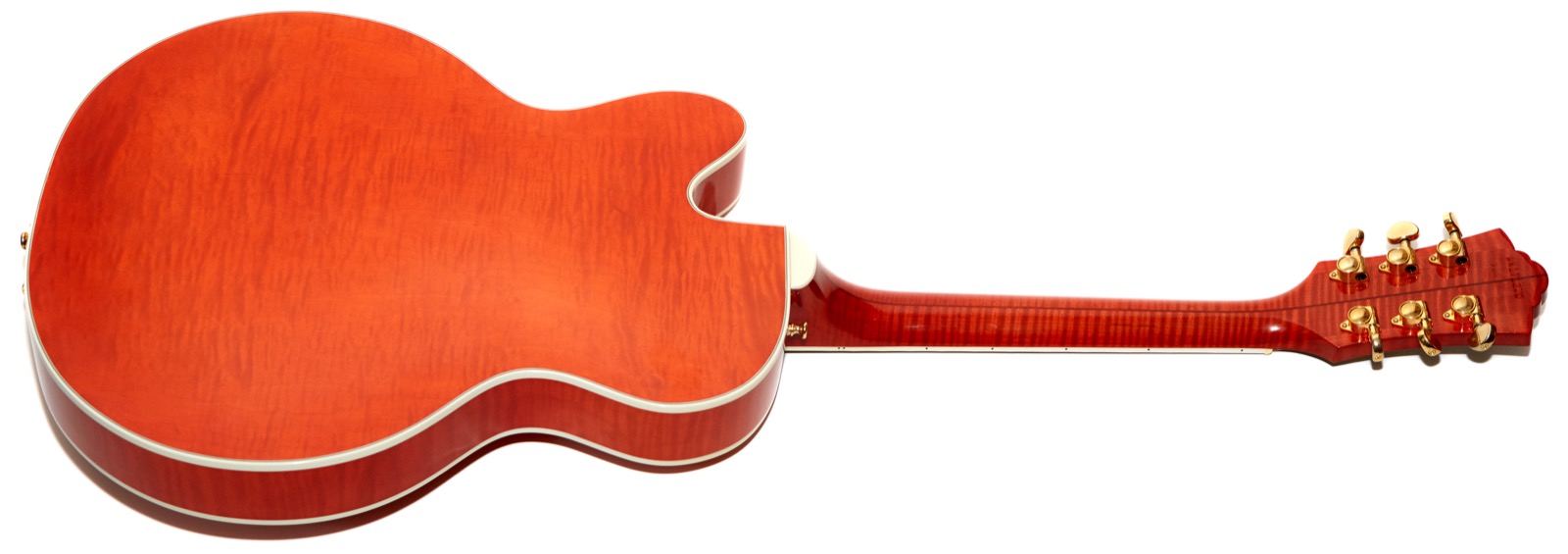
I’ve spent a lot of time, money, and energy trying to get a Guild to sound like Brian Setzer’s guitars and I won’t even go into how much time and effort I’ve spent trying to get my fingers to behave like his, but this guitar with the alterations I’ve applied is absolutely it for me.
This one’s a keeper. Highly recommended.
Donate: PayPal Crypto:
ETH: 0x0AC57f8e0A49dc06Ed4f7926d169342ec4FCd461
Doge: DFWpLqMr6QF67t4wRzvTtNd8UDwjGTQBGs

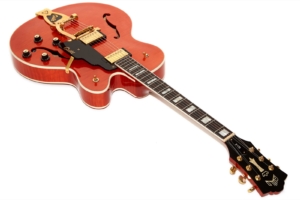
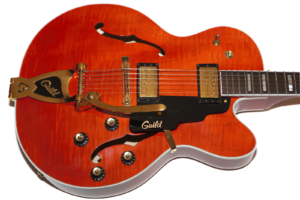

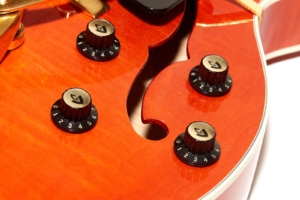
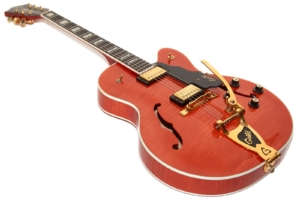
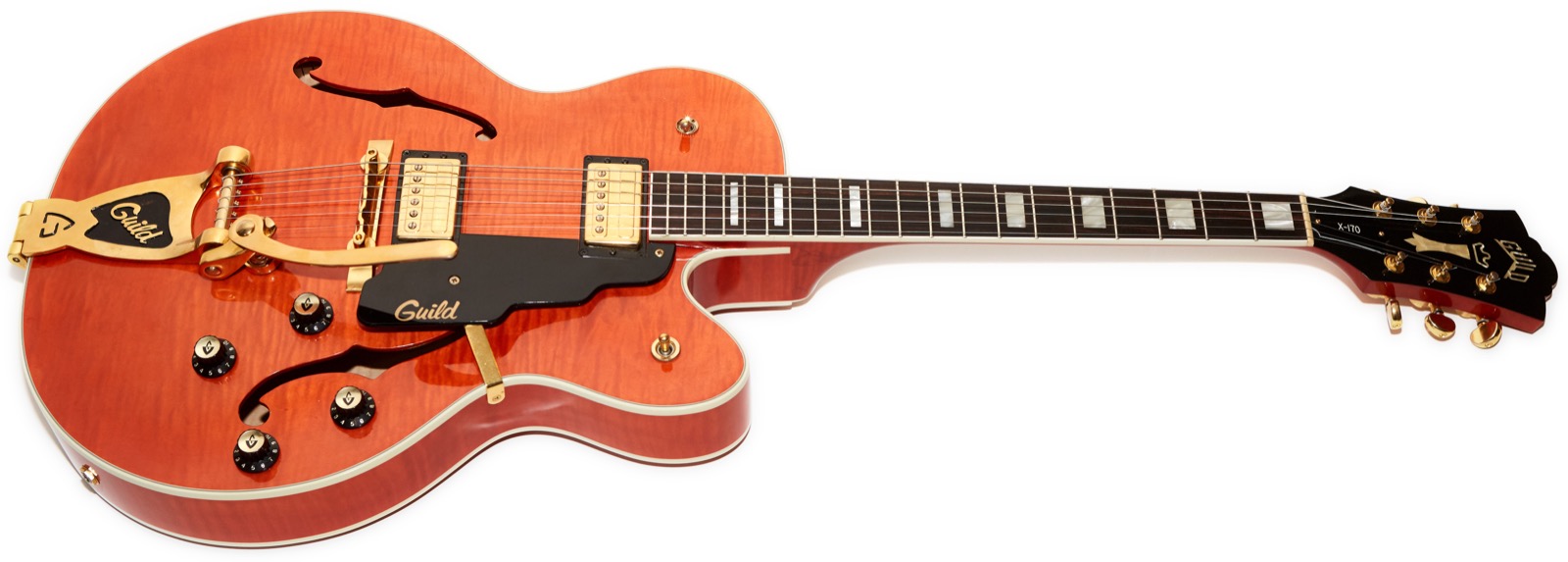

Gary-
Thanks for the review – and the site more broadly; it convinced me to get one of these, a ‘98 X170B without the coil tap. You ever think of putting a different set of humbuckers in? Just curious before pulling the trigger on some Setzers since I already have a guitar loaded with TVJ supertrons. Anyway, thanks again for all your reviews.
so what should I expect to pay for this ax in mint cond with nice Gibson hardshell case that fits ???
Here in mid-2019 I would pay ~$1200 for one with the original case in mint condition.
I purchased a 2000 model a few years ago that exact color and model. The x170 is the odd one out because of the 2-1/2″ body thickness and huge glued-in tone sucking sound bar and because of this it doesn’t resonate acoustically (IMO) also it has a pretty thin neck. The stock pickups sounded very bright and needed changing out, something I didn’t do so I traded it. Construction is very high quality I payed 1200. It is a beautiful guitar. I would think prices would be double if it had a 3″+ body and no sound post they should have built them that way. Thanks
Hi Gary,
When you dropped the TV Jones Filtertrons into your X170T Mars, did you use TV Jones pickup rings like this? https://tvjones.com/em1-gibson-style-pickup-ring-with-mounting-screws/
I recently got a 1989 X160 wanted to replace the rather uninspiring and bassy pickups, but the screw holes are totally different with TV Jones ring. Did you need to drill new holes for yours?
Toby
A 1989 X160 should have Guild HB1 pickups in it which are killer and anything but bassy. I would look at the pots before replacing the pickups, unless the pickups aren’t original. If you send me a picture of the pickups (front and back if possible – front if not) I can tell you what they are.
As for the rings, I want to say yes, but the X170T had Fender HB1 pickups which are the same size as “normal” humbuckers. If your guitar has original HB1s, then those pickups are a different size and the holes likely won’t line up.